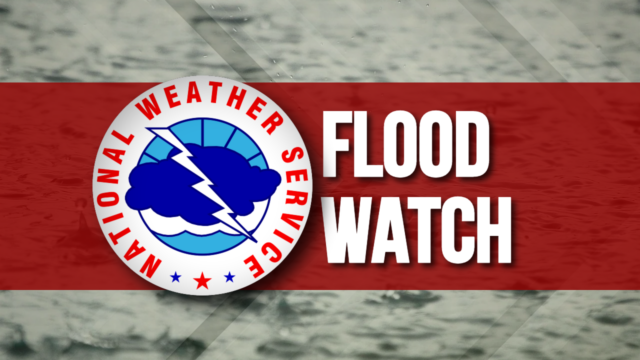7:00 A.M. MONDAY UPDATE:
Three deaths in Georgia over the weekend are due to fallen trees. A strong storm led to the death of a father and son when a tree fell on top of their cart at Bull Creek Golf Course near Columbus as they took shelter Sunday.
So far, no storm-related damage has been reported in the Gainesville area; rainfall at the Gainesville airport as of 7:00 this morning totaled about 2.5 inches.
EARLIER STORY. POSTED 10:15 SUNDAY NIGHT:
Hall and all surrounding counties as well as others in north, central and now, parts of southwest Georgia are included an expansion of the Flood Watch that was issued Saturday. It is effective until Monday night, according to the National Weather Service (NWS).
Forecasters say “the severe threat continued to diminish Sunday evening; however, widespread rain & embedded storms will continue to stream across much of the area into Monday. Locally heavy rainfall will remain possible, which may lead to increased flooding potential.
“For this reason, a Flood Watch remains in effect through Monday evening for most of the area. Additional heavy rainfall amounts could cause flooded roads as well as creeks, streams, and low-lying areas.”
By 10:00 Sunday night, about two inches of rain had fallen at the Gainesville airport though no strong winds had been recorded.
That was not the case in parts of metro Atlanta where trees were toppled in some places. Parts of west Georgia and areas to the south of Atlanta were under tornado watches and warnings for a time Sunday afternoon.
Meanwhile, days of unrelenting heavy rain and storms that killed at least 18 people worsened overnight flooding as some rivers rose to near-record levels and inundated towns across an already saturated U.S. South and parts of the Midwest.
Cities ordered evacuations and rescue crews in inflatable boats checked on residents in Kentucky and Tennessee, while utilities shut off power and gas in a region stretching from Texas to Ohio.
“As long as I’ve been alive — and I’m 52 — this is the worst I’ve ever seen it,” said Wendy Quire, the general manager at the Brown Barrel restaurant in downtown Frankfort, Kentucky, the state capital built around the swollen Kentucky River.
“The rain just won’t stop,” Quire said Sunday. “It’s been nonstop for days and days.”
Officials diverted traffic and turned off utilities to businesses in the city as the river was expected to crest above 49 feet Monday to a record-setting level, said Frankfort Mayor Layne Wilkerson. The city’s flood wall system is designed to withstand 51 feet of water.
For many, there was a sense of dread that the worst was still to come.
“This flooding is an act of God,” said Kevin Gordon, a front desk clerk at the Ashbrook Hotel in downtown Frankfort. The hotel was offering discounted stays to affected locals.
The 18 reported deaths since the storms began on Wednesday included 10 in Tennessee.
EARLIER STORY. POSTED 10:15 SUNDAY NIGHT:
Meanwhile, Kentucky Governor Andy Beshear said on Sunday that two people died and over 500 roads were closed in the state due to deadly storms and floods, which have also killed over a dozen people in the past week in other states of the South and Midwest.
“Kentucky, there is record flooding across our state, with over 500 road closures. Rivers have not yet crested, so we still have a day — if not more — of rising waters. We’ve already lost two of our people,” Beshear said on social media platform X.
One of the dead in Kentucky was a 9-year-old boy walking to his school bus stop on Friday morning when he was overtaken by flooding, police in the city of Frankfort said.
Beshear added on Sunday that many homes were evacuated and water supply was limited in the state capital Frankfort, where he said state offices will be closed on Monday.
A deadly spring storm spawned tornadoes and drenching thunderstorms in a swath of the U.S. stretching from Texas to Ohio in the past week.
Tennessee had 10 deaths in this period, according to the local health department. In addition to the two deaths announced by the Kentucky governor, there were also two deaths in Missouri and one each in Arkansas, Indiana and Mississippi, according to local media.
Climate change is bringing heavier rainfall and related flood risks in most parts of the U.S., with the upper Midwest and Ohio River Valley among the regions most affected, according to Climate Central, an independent nonprofit that researches weather patterns.
(SRN NEWS/REUTERS AND GEORGIA NEWS NETWORK CONTRIBUTED TO THIS REPORT)


